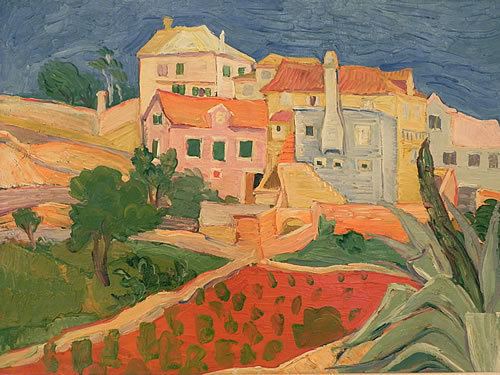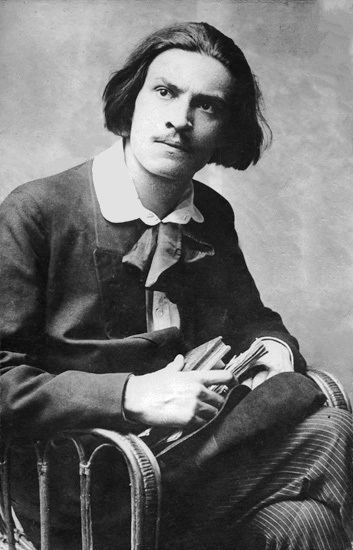Name Ignjat Job | Known for Painting | |
 | ||
Died April 28, 1936, Zagreb, Croatia | ||
Ignjat job 1895 1936
Ignjat Job (28 March 1895 – 28 April 1936) was a Croatian painter from Dubrovnik.
Contents
- Ignjat job 1895 1936
- Offer 4 paintings Bijelic Milovanovic Job Tatum
- Biography
- Legacy
- Works
- Exhibitions
- Solo Exhibitions
- Group Exhibitions
- Public Collections
- References

He was an important representative of colour expressionism in the art scene of Yugoslavia during the 1930s. His landscapes of Dalmatia are reminiscent of the style of Van Gogh. He is best known for his series of paintings inspired by life on the island of Brač. Job himself said that “the beneficial influence of the Brač landscape can be felt, the hot sun, blue sea, and green branches of olive trees swayed by the breath of the maestral”. His paintings depicted the Mediterranean landscape, motifs of the town of Supetar, fishing themes, and more rarely portraits and nudes.

Offer 4 paintings Bijelic, Milovanovic, Job, Tatum
Biography

Ignjat Job was born in Dubrovnik, on 28 March 1895. His father died when young Ignjat was only 5 years old. He attended school in Dubrovnik until 1910. An important influence on his early intellectual and artistic development was his older brother Cvijeto (1892–1915), whose art studies in Belgrade and Munich came to an end when he went off to fight in the First World War. As an active supporter for independence from Austria-Hungary, the young Ignjat Job was arrested in 1912 along with other young nationalists and sentenced to one month in prison. In 1913, while Job was only 18, his first daughter, Marija was born. Arrested again in 1914, he spent time in Šibenik prison, then removed to a mental hospital, thanks to good connections, until September 1916. Traumatic experiences from his two-year stay in the mental hospital oppressed Job in the years that followed, and left a mark on his work, most notably on Madmen in the Yard, a drawing thought to have been made between 1916 and 1919.

In 1917 Job moved to Zagreb with his mother and younger brother Nikola, where he enrolled in the Arts and Crafts College (Viša škola za umjetnost i umjetni obrt). Job fell in love, and married Viktorija Oršić. After spending the summer in Dubrovnik and on Lopud, the couple moved back to Zagreb for the autumn. However, the relationship was not to last, and they divorced in 1920. In that same year, Job's mother died, and due to irregular attendance, he lost his place at college. The family fortune had been used up in enforced war loans, the purchase of the flat in Zagreb, and the education of the children. Job now found himself dependent on the goodwill of friends, and increasingly prone to bouts of depression and ill-health.

In December 1920, Job went to Italy, visiting Rome, Naples and Capri. Travelling back through Dubrovnik and Zagreb, he went on to Belgrade, spending time there with local modernist artists - most notably Petar Dobrović. There also, in 1923, Job met and married his second wife, Živka Cvetković, and their daughter Cvijeta was born in the summer of 1924.
In the spring of 1925 Job was diagnosed with tuberculosis, and spent the summer being treated at Ovčar-Kablar Gorge, after which the family moved to the village of Kulina, near Kruševac. There he painted his memories of the coast, mostly on small panels.
In October 1925, Job's son Rastko was born, but fell ill and died in March the following year. The death of his infant son left a deep impression on Job's mental and emotional state.
In the summer of 1927 the family moved to Vodice, near Šibenik, and from 1928 they lived in Supetar on the island of Brač. There, Job embarked on the most creative time of his artistic career, and his style began to resemble that of Van Gogh. Job's focus was on recording the impulse of his personal feelings, and strong expressiveness became a feature of his work. The following year, 1929, he held his first solo exhibition in Split, which was well received by public and critics alike. By his next solo exhibition at the Salon Galić in Split, Job's style had developed more toward expressionism.
Between 1934 and 1935, Job lived in Belgrade and Zagreb, then returned to Supetar. He died of tuberculosis in a Zagreb clinic on 28 April 1936.
Legacy
Ignjat Job's best, most creative and expressive work was produced in a very short period of time. In the early 1920s, his painting still shows the influence of the Spring Salon, with rounded forms in more muted colours. However, inspired by the scenes of his native Dalmatia, and driven by his own personal demons, Job went on to become one of the most expressive painters in the Croatian modern art scene of the 1920s and 30s. In his later works he demonstrated fauvism techniques and strong, expressive use of colour. Job saw landscape as a symbol, and used colour as an expression of his emotions, his personal experience of life and his reaction to the environment and its native people. His art was grounded in the earthy island lifestyle, and he pursued his own personal vision. As the critic Igor Zidić says "All of the content in Job's work, from 1928 to his death, are locally and regionally marked, always concrete, borrowed from the real world and the little towns of Dalmatia in which he scrimped and lived, full of ambiental tone and colour, melodies, events and figures... He was a careful observer, with a lot of sense for humour, for the comic and tragicomic, for the mad, the ridiculous, the fantastic and the drunk."
The majority of Job's works are on display at the Branislav Dešković Gallery in Bol.
Works
Images of Ignjat Job's paintings can be seen online at the Adris Group website, Arte Galerija, and Galerija Remek-Djela:
Exhibitions
During his lifetime, Ignjat Job held exhibitions of his work in Split, Zagreb and Belgrade.
Solo Exhibitions
Recent exhibitions of his work include:
Group Exhibitions
Public Collections
His work can be found in the following public collections:
Croatia
Serbia
